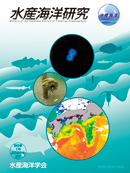Massive occurrences of juvenile clams Ruditapes philippinarum have been appearing every spring at Rokujo tidal flat located in the Toyo River mouth region at the eastern part of Mikawa Bay. These have been collected by licensed fishermen and transplanted into the coastal shallows of Ise and Mikawa Bay. However, the Manila clam population have been showed a tendency to decline sharply from autumn to winter in recent years. To understand this phenomenon, we conducted field observation about its population change, catch effort and the appearance of predators from autumn 2015 to spring 2017. In addition, we continuously monitored water temperature, chlorophyll a and near-bottom currents condition. At first, we examined growth and the survival situation of clams by the usual growth model that assumes water temperature and the quantity of phytoplankton as variables, using data from autumn to winter 2015, when mortality was remarkable. However, we couldn’t represent the physiological death. Then, we improved the model that considered an energy loss of dig caused by wind wave, too. As a result, population changes were correctly expressed. Therefore, we find that an energy loss might have an important role for growth and the survival situation of clams in the shallows where wind wave is remarkable especially in the case of insufficient food condition.
View full abstract
